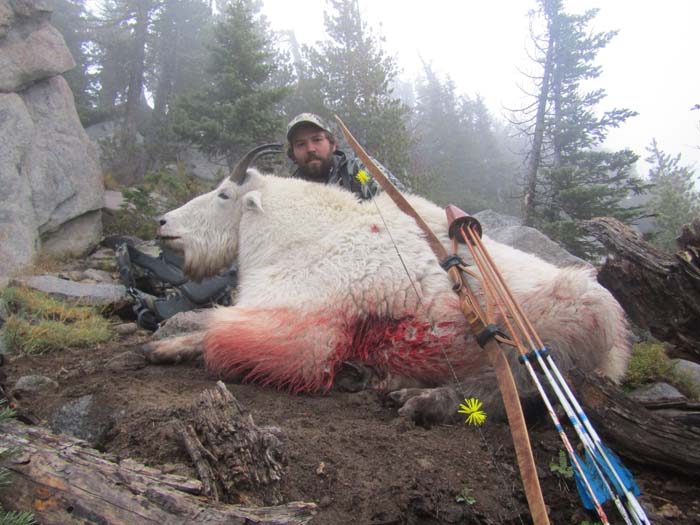Mountain goat tests hunter’s nerve. … and teeth
Published 1:34 pm Friday, November 17, 2023

- Daniel Embertson of Riddle, near Roseburg, killed this mountain goat billy with his traditional longbow on Oct. 2, 2023, in the Elkhorn Mountains south of Anthony Lakes.
BAKER CITY — Daniel Embertson was totally focused on stalking the mountain goat until he realized he was about to fall off a cliff.
Trending
This predicament temporarily shifted his attention.
“It kind of scared me,” said Embertson, a 31-year-old hunter from Riddle, a small town in Douglas County about 23 miles south of Roseburg.
His perilous perch was along the granitic crest of the Elkhorn Mountains near Cunningham Saddle, about 4 miles south of Anthony Lakes.
Trending
It was the afternoon of Oct. 2.
Embertson had beaten steep odds just to be here, at over 8,000 feet elevation on a cool, misty autumn day.
He was one of three hunters to draw a tag to hunt mountain goats in the Elkhorns during October.
The year before, about 2,500 people applied for one of those tags.
As he clutched his traditional longbow, Embertson began to wonder whether, in his attempt to creep closer to the billy goat he had seen earlier, he had misjudged the terrain.
And his own abilities as a mountaineer.
Embertson was standing on a ledge perhaps 2 feet wide, just east of and below the comparatively gentle crest of the ridge.
He looked ahead and saw a V-shaped notch leading back to the top, where he had last seen the billy.
“It looked like a cliff,” he said.
But when Embertson looked back along the ledge, it seemed to him that the ground he had already navigated was equally treacherous.
He disliked both options.
“I figured I might as well try to go forward,” he said.
Holding the bow’s handle loosely with his right hand, he wedged the fingers of that hand into a crack.
“Luckily those granites are pretty grippy,” Embertson said.
He regained the crest without mishap. He nocked an arrow.
And as he did, Embertson saw the billy, bedded down just 10 yards or so away.
Then the billy saw him.
The goat stood and took two steps away from Embertson.
Then the goat paused and turned its head to look at Embertson. The billy was about midway between broadside and facing directly away.
Embertson fired the arrow.
It struck just behind the billy’s shoulder.
The goat ran a short distance and fell.
Embertson had finished a hunt he never expected to start.
A shocking revelation
That hunt started, in effect, more than three months earlier and in a setting dramatically different from that precarious ledge.
Embertson was sitting in his office on June 15.
His brother texted.
The draw results from Oregon’s hunting tag lottery were out.
This is a milestone for many hunters, Embertson among them. He’s been hunting since he was old enough to buy a tag, at age 12.
As he does most years, Embertson had applied for many tags. But he wasn’t expecting to draw anything other than maybe an elk or deer tag.
He applied for statistical longshots, such as a bighorn sheep or mountain goat tag, more out of habit than of any anticipation of success.
Embertson put in for one of the three October tags for the Elkhorns hunt for two reasons.
First, he has hunted elk in the Sumpter unit several times and is familiar with the Elkhorns.
Second, Embertson said the odds for drawing a tag for the October hunt, although still minuscule, are slightly higher, by a fraction of one percent, than for the two other seasons.
(The state sells 30 total tags, statewide, for mountain goat hunting each year. Nine of those tags are for the Elkhorns, distributed among three month-long seasons, one each in August, September and October.)
As he perused his draw results he noted that he had a doe tag for a unit near his home.
No surprise.
“I get that every year,” Embertson said.
But there was another line on his list of tags.
He looked closer.
“I thought it said goat,” Embertson said.
He checked again.
“I almost dropped my phone,” he said.
The word was, indeed, “goat.”
Ready to hunt
Although Embertson assumed he would never draw a mountain goat tag, he had nevertheless put together an itinerary for this hypothetical hunt.
The plan was based on his elk hunts in the Elkhorns.
He had seen lots of goats during those trips.
The goat population in the Elkhorns numbers around 300, based on surveys by the Oregon Department of Fish and Wildlife.
Embertson decided he didn’t need to take any scouting trips prior to October.
“I knew where the goats were for the most part,” he said.
On the last day of September he drove across Oregon, prepared to start hunting on the first day of the season.
He took a week off from work.
Embertson had not only decided where he would hunt, but also the weapon he would carry.
It’s a Liberty Edge longbow, custom-made by Liberty Bows of Roseburg. He bought the bow about five years ago and had taken a couple of buck deer with it.
On the first day of October, a Sunday, Embertson hiked the steep trail to Killamacue Lake, just north of Rock Creek in the central Elkhorns west of Haines.
“I had seen some big goats up there,” he said.
Embertson came across eight goats high on the south slope of Red Mountain, at 8,928 feet the third-highest summit in the range.
One was a billy just 10 yards away.
But it was only the first day of the season, and Embertson decided to pass up the shot.
On the season’s second day, Monday, Oct. 2, he moved his camp to near Anthony Lakes. He was camping with his dad, Terry Embertson, who lives in Roseburg.
That morning, Daniel Embertson hiked the Crawfish Basin trail, just southwest of Anthony Lakes, to the Elkhorn Crest Trail. He headed south a mile or so to Cunningham Saddle.
Embertson first saw a group of nannies and kids.
Then he spotted a relatively big billy, which was joined soon after by a second, much smaller, billy.
The goats were about 55 yards away.
“Way too far for a longbow,” Embertson said.
He thought he might be able to flank the larger billy by dropping off the crest to the east.
Not long after he was standing on that ledge, scarcely wider than his boot, and wishing he was somewhere else.
Tough but tasty
The hunt, of course, didn’t end when the billy slumped over.
Embertson had 250 pounds or so of goat to deal with.
When he finished dressing the carcass, the sun had almost slunk to the western horizon.
Embertson had been talking with his dad by two-way radio, but the batteries died on the elder Embertson’s radio. He had started back to camp.
And Daniel couldn’t find his headlamp.
He ended up lashing his cellphone to his binocular harness and aiming the flashlight straight ahead.
He walked about 3 miles that way through the gathering gloom, with a third of the billy strapped to his pack.
Embertson estimated the billy’s age at about 7, based on the number of rings on its black horns, which are 9 1/4 inches long.
He said the meat had good flavor — “about like beef” — but the flesh was as much a workout for his jaws as the Elkhorns’ topography was for his legs and lungs.
“It was extremely tough — the toughest meat I’ve ever tasted,” Embertson said.
Appropriate, perhaps, considering the difficult spot he ended up in just before firing the fatal arrow.
“Luckily those granites are pretty grippy.”
— Mountain goat hunter Daniel Embertson, who appreciated the friction of the rock in the Elkhorn Mountains during a precarious situation on a narrow ledge while hunting on Oct. 2
Most of Oregon’s mountain goats live in the Elkhorn or Wallowa mountains.
There are smaller populations in the Strawberry Mountains south of Prairie City, in Hells Canyon, in the Wenaha unit of northern Union and Wallowa counties, and in the Cascade Mountains near Mount Jefferson. There’s also a frequently visible herd in the Perry area along Interstate 84 just west of La Grande.
The Oregon Department of Fish and Wildlife sells 30 mountain goat hunting tags each year.









